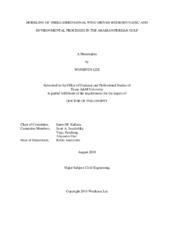| dc.description.abstract | A three-dimensional hydrodynamic model has been developed to investigate thermohaline processes, ocean circulation driven by winds, and other hydrodynamic features in the Arabian/Persian Gulf area. The validated model can be used to study a wide array of effects and processes in the region, with potential application to future climate scenarios and the resultant effects on oceanic processes.
In the first part of this dissertation, a three-dimensional hydrodynamic model is developed for the Arabian/Persian Gulf; details regarding model grid resolution and forcing are discussed therein. The model is validated with data from field measurements offshore of Kuwait collected by the Texas A&M University at Galveston (TAMUG) Microstructure Group in 2013. Furthermore, with the validated model, we conduct a sensitivity study to determine the most significant driver of thermohaline processes in the Gulf region. The evaporation and precipitation rates and winds are significant influences on the physical and hydrodynamic processes in the Gulf, and the local salinity changes near the river estuary were affected by the northern rivers.
In the second part of this work, several applications of the validated model are conducted to study various processes in the Gulf; these include the effects of desalination process and extreme conditions on the thermohaline characteristics. The model is able to identify the effects of brine discharge on desalination, by investigating the variations of salinity and temperature from the desalination process in the Arabian/Persian Gulf. The modeling system could also be used to evaluate the impacts of Cyclone Gonu 2007, developing the hydrodynamic (FLOW) and coupled (FLOW+WAVE) models. The models show the high vulnerability of the Gulf coast, and
the spatial and temporal variations in salinity and temperature due to the massive inflows of fresh water from the Indian Ocean.
The final part of this dissertation includes the summary and discussion of this work, and future research with the effect of climate change, which can affect established weather patterns and, consequently, the ocean circulation and environment in the Gulf region. The modeling system will provide an important perspective on global climate change in the data scarce Gulf region. | en |


